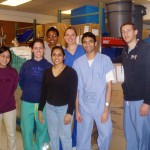Volunteers are needed throughout the year, including summer and semester breaks to pick up surplus supplies from collection bins at Duke North and Central Tower locations and to help sort and inventory supplies at the Duke Health warehouse at 100 Golden Drive.
If you would like to volunteer with REMEDY at Duke, send an email expressing your interest and availability to john.lohnes@duke.edu.
All volunteers must be age 18 or older and capable of performing light physical activity. Unfortunately the REMEDY space at the warehouse is upstairs and is not ADA accessible. There is no minimum number of hours required to volunteer with REMEDY. Safety and compliance training will be provided by the REMEDY coordinators.
Duke students can sign up here for either activity: https://duke.box.com/s/tbvfvukkb92uiw8zk5cx0euwg8mjjubd
If you are looking for patient care volunteer experience, consider one of the many Duke Hospital volunteer programs offered through Duke Hospital Volunteer Services, call 919-681-5031 or go to: http://www.dukehealth.org/patients_and_visitors/volunteer_services/programs
Pickup Procedures:
REMEDY collection bins are currently located in the following areas at Duke North and Central Tower and should be picked up weekly and delivered to the large green rolling collection bins located on Level 0 (click on the “How To Donate Supplies” tab to find the Level 0 bins). Please bag all items before placing in these bins.
| Department | Location |
| Orthopedics + trauma | 11th floor, DCT (11B) |
| Bone Marrow | 10th floor, DCT (10A + 10B) |
| Neuroscience | 9th floor, DCT (9A + 9B) |
| Congenital Heart | 3rd floor, DCT (3B) |
| Emergency department | ED |
| Postpartum | 5300, Duke North |
| Oncology | 9300, Duke North |
Sorting, Packing and Inventory Procedures:
Warehouse sorting sessions are typically held twice a month on Thursdays from 6:00-7:30 pm at the Duke Health warehouse located about 3 miles from Duke West Campus at 100 Golden Drive. Volunteers should assemble in the parking lot behind the building (follow signs to Deliveries and Surplus).
APRIL 2024 SORTING SESSIONS: Thursday, April 4 and Thursday, April 25 from 6:00-7:30 pm
Wear comfortable clothing appropriate for light physical work including bending, kneeling and lifting. Please wear closed toed shoes (no sandals). Before sorting or packing any materials, put on a pair of disposable gloves, available in the collections area.
SORTING:
- Empty new surplus from boxes or bags and place each item in the appropriate labeled sorting bins on the shelves.
- Unusable, damaged, or soiled items should be discarded in the trash bin located in the sorting area.
- Corrugated cardboard should be recycled in the box crusher on the first floor.
- Discard any unprotected needles, blades or other sharps in the red “sharps” disposal containers located in the collections area.
- Discard any syringes or sutures that are not in their sterile peel-pack package.
- Highly specialized or technically complex items or supplies are generally not suitable for overseas donation, but some may be donated to one of our teaching labs. Examples include cardiac catheterization cannulas, endoscopic or other specialized surgical devices, or devices that require specific machinery or equipment to operate.
- Expired blood collection tubes, arterial blood gas syringes, IV solutions (bags or flush syringes) should be discarded.
- Containers with liquids (e.g. scrub soaps, iodine, alcohol, etc.) should be inspected closely for leaks and discarded if any are found. Place these in plastic bags before packing.
**If you are unsure what an item is or whether it should be packed, just leave it and we will make a determination later.
PACKING and INVENTORY:
- Items ready for donation should be packed in one of the cardboard boxes available in the collections area. Whenever possible, put similar items together in the same box, rather than an assortment of unlike items. Liquid containers should be placed in a plastic bag before being packed.
- Write with a marker on the side of the box the general contents, (e.g. “antiseptics”, “exam gloves”, “bandages and dressings”), the approximate quantity and the expiration date if applicable.

